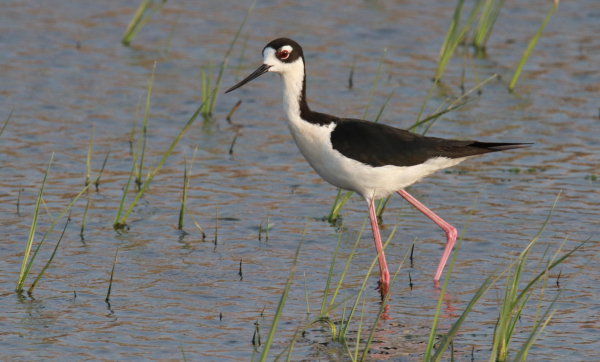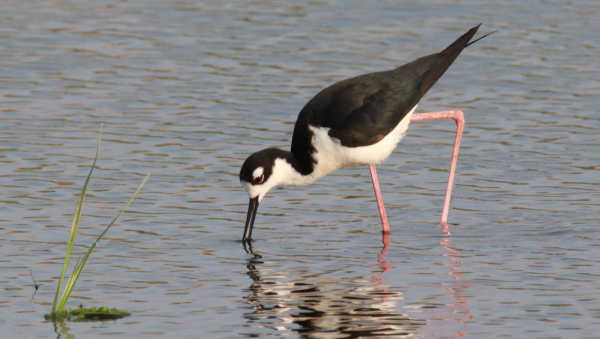On the first day of summer, an especially nice blue sky afternoon made me excited to check on the birds of Hecla Marsh and the potential for some photography. Among the many birds on hand, one species stood out, partly because of its relative rarity in the Northern Great Plains, but also due to the elegance of the single Black-necked Stilt as it waded through shallow water, slipping between emerging strands of green sedges to provide a beautiful portrait of the species in a pleasing habitat setting where it searched for food.

With the Black-necked Stilt wading through a rather picturesque habitat, I wanted to compose my photographs with the bird positioned to one side of the photo, so there was some open space in front of it, which I think adds a little more character to a photograph than if the bird is centered in the photo frame (600mm zoom lens, f-10 aperture, 1/800 shutter speed, 800 ISO).
As I photographed, I waited for the graceful stilt to turn into the direction of the sunlight to highlight its distinctive black and white plumage and bright pink legs. While I was positioned close enough to zoom in to emphasize the stilt, I wanted to compose my photographs to show the bird in its habitat, which was quite pleasing as an element in the photos. I always prefer to position the subject of my photos to one side of the photo, so there is some open space in front of it, to add a little more character to a photo than if the bird is centered in the photo frame.

Using the “rule of thirds” as a guide when composing this and other photos as the stilt foraged in the shallows, I also used a wider than usual f-10 aperture setting to keep more of the foreground and background in focus (600mm zoom lens, f-10 aperture, 1/640 shutter speed, 800 ISO).
I could already foresee using a couple of these photographs in this Bird Photography feature, which provides the opportunity to insert photos the full width of the page, so when I edited the photograph, I cropped it to make it a bit more elongated and to include even more of the surrounding habitat. The finished images show the stilt on the right side of the photograph facing into open water for it to walk into. I find this treatment very pleasing, and it is a fairly familiar design method used by artists and photographers that is referred to as the “rule of thirds.”

After a pair of Black-necked Stilts attacked the first stilt, sending it on a fleeing flight, the original stilt suddenly returned with a counter attack that made one of the pair dive below the water surface. In this photo, as the original stilt landed, the attacked stilt was beginning to rise with water still dripping off its back, head, and beak (600mm zoom lens, f-10 aperture, 1/640 shutter speed, 800 ISO).
Of course, it’s not really a “rule,” but it is said that this technique enhances the visual interest and composition of a photo or artwork, and I agree with that assessment in many applications. But each photograph is unique and so is its composition, whether it is composed in-camera or by cropping after the photo has been taken. Sometimes, zeroing in on a bird is most dramatic, and centering your subject is always an option if it helps to emphasize interesting behavior or a point of action. And that’s what happened when the tranquil scene I was viewing through my camera lens was suddenly shattered as another stilt dived into view, attacking the first Black-necked Stilt.

After taking a couple quick steps to escape, this stilt took flight, showing its long pink legs dripping a few water droplets (600mm zoom lens, f-10 aperture, 1/1250 shutter speed, 800 ISO).
There were actually 2 stilts involved in the habitat takeover, a male and female, an apparent pair. The first stilt flew out of my view, and my attention was drawn to the apparent pair, especially the female that showed a browner hue to its plumage on its dorsal side. But the pair’s foraging bout didn’t last long as the original Black-necked Stilt returned to reclaim its feeding area by diving on one of the stilts, causing it to submerge into the water for a moment in advance of its full-fledged escape!
Action photos are usually a top level chance to get unique images of birds, but I was a moment late in perceiving this split-second attack, so my best photo op was when the attacking stilt was landing over the attacked stilt. The attacked stilt was still mostly submerged but elevating above the surface of the water, and the resulting photo shows water falling from its back, head, and beak. The wary attackee took a couple quick steps and sprang into flight, which I was able to photograph in motion at 1/1250 using an f8 aperture.

A few moments later, the original Black-necked Stilt melded back into a more open water habitat, providing an image of the stilt in motion on one side of the photograph as it stepped through clear blue water (600mm zoom lens, f-10 aperture, 1/1250 shutter speed, 800 ISO).
Thereafter, the original Black-necked Stilt settled into another quiet bout of foraging, wading along the edge of open water and providing a couple closing images before I took flight myself. It’s always rewarding when a bird accepts my relatively distant approach to a position with the sun at my back then to have that bird and the birds around it to act without concern for my mobile blind (white car) and continue to behave as they would in my absence. The chance to photograph a bird in a tranquil habitat setting was rewarding, but there was no way to predict it would lead to 2 dramatic territorial interactions, then return to the tranquil scene that originally attracted me showed the power of spending some time at a location with a bird – ‘cuz ya never know what might happen next, or in another minute or more.
Have you been surprised by some unexpected bird behavior lately with your camera in hand? Or have you had opportunities to photograph birds surrounded by attractive habitat lately? During these early days of summer, I hope you have a wealth of bird photography opportunities, and hope you have ample time to search them out – in the field, your yard, or any area of greenspace – Good Luck!
Article and Photographs by Paul Konrad
Share your bird photos and birding experiences at editorstbw2@gmail.com